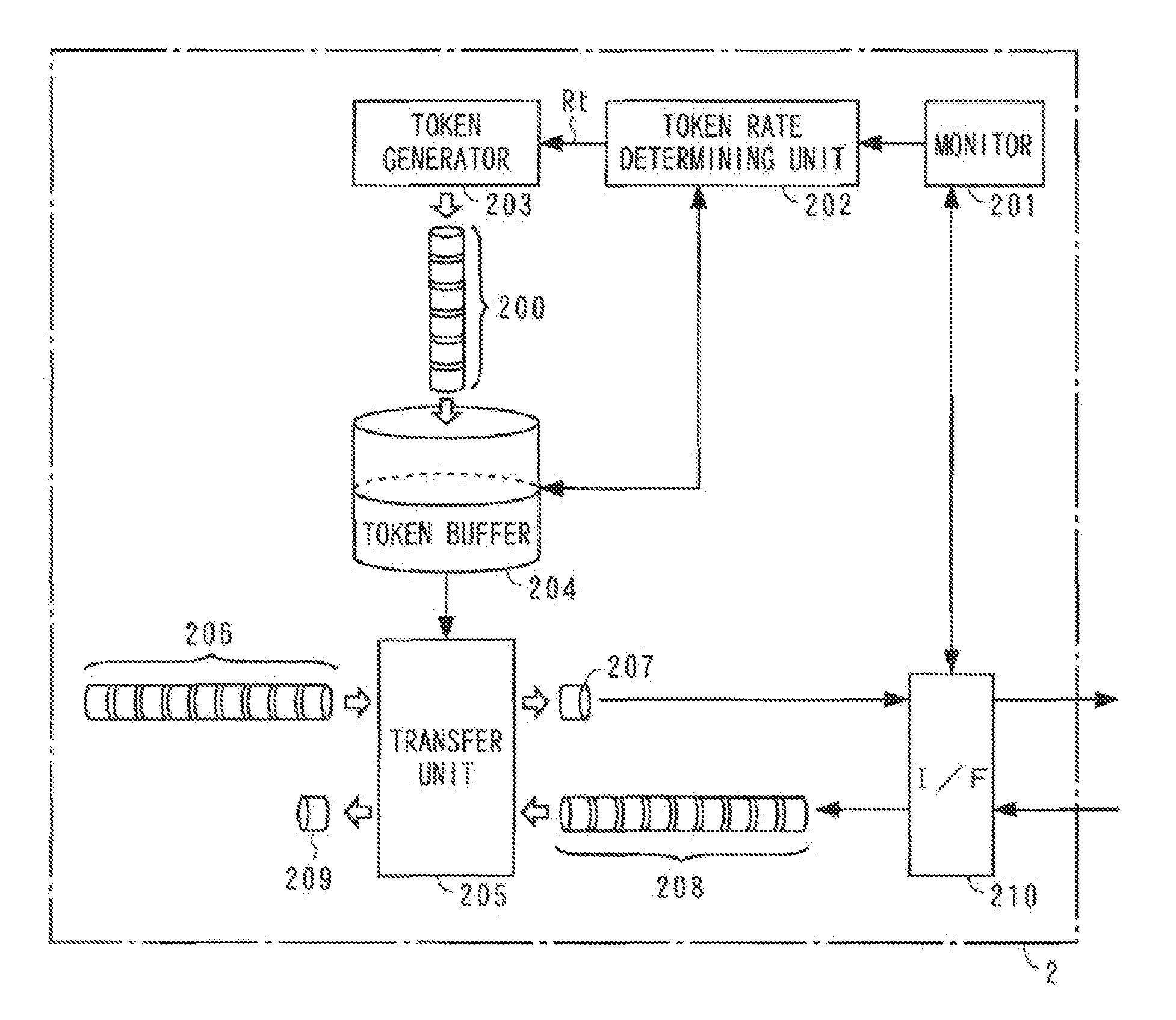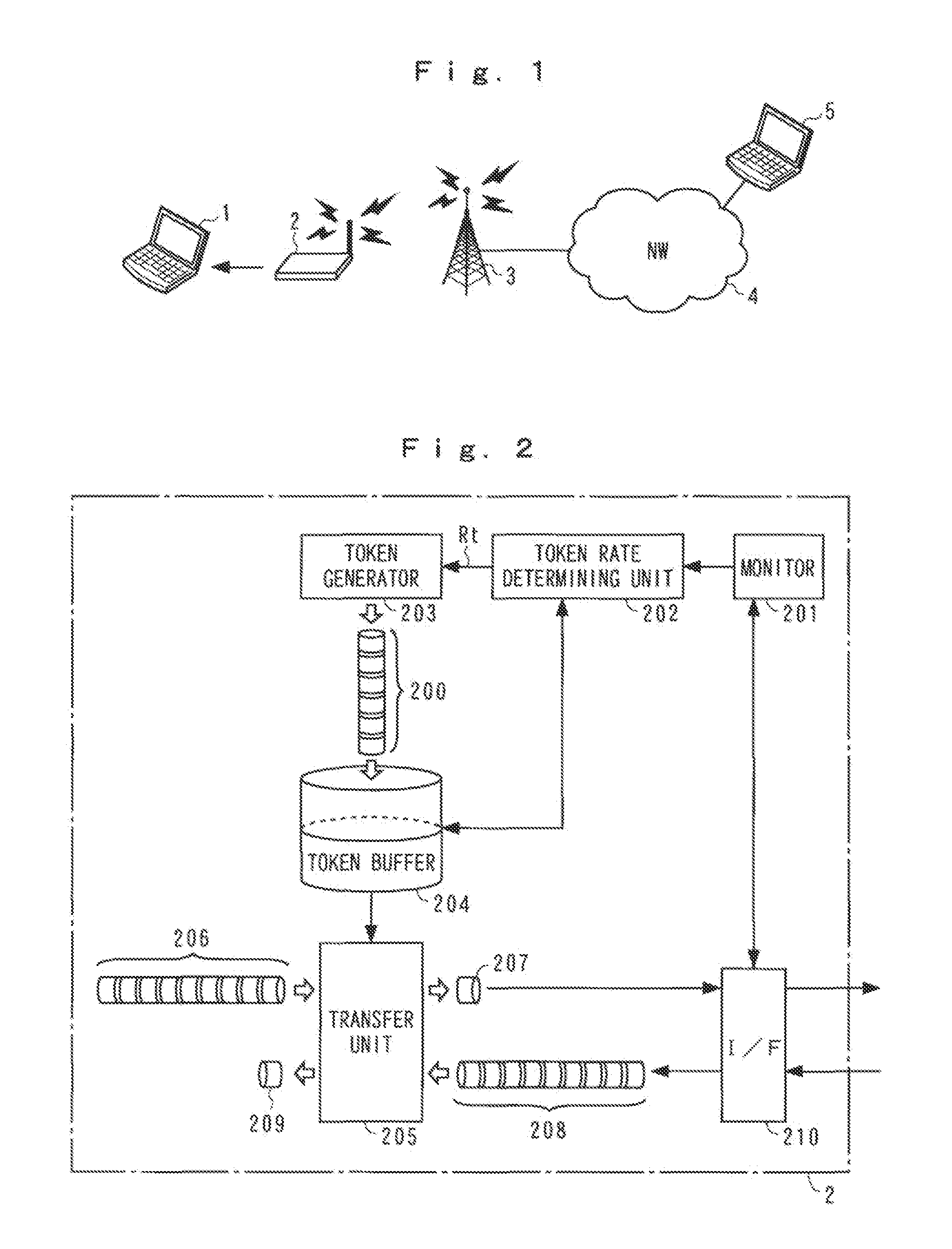Traffic control method and apparatus for wireless communication
- Summary
- Abstract
- Description
- Claims
- Application Information
AI Technical Summary
Benefits of technology
Problems solved by technology
Method used
Image
Examples
first embodiment
[0046]An operation of the embodiment of the present invention shall now be described in detail with reference to the block diagram together with flowcharts and a time chart. FIG. 4 is a flowchart of operation of the first embodiment and mainly shows a traffic control operation at the wireless node 1. FIG. 5 is a time chart thereof.
[0047]In step S1, the throughput R0 of the wireless node 1 is detected by the throughput detector 101. The throughput R0 increases and decreases depending on the token rate Rt at the communication modem 2 and thus serves as an index that represents the congestion of the wireless section or the network 4. In step S2, the throughput R0 and the threshold value Rref are compared at the comparator 103. If the throughput R0 falls below the threshold value Rref, as before time t1 in FIG. 5, it is judged that the token rate Rt at the modem 2 is high and a serious congestion is not occurring at the network side and the above process is repeated upon returning to st...
second embodiment
[0059]An operation of a second embodiment that adopts the above dormant mode shall now be described according to each of the options.
[0060]FIG. 7 is a flowchart of an operation unique to the option A, and symbols that are the same as the above express the same or equivalent portions.
[0061]When in step S3, the release request unit 104 requests the release of the wireless resource, the controller 100 detects the release request in step S31 and then step S32. In step S32, just the physical connection of the wireless layer is disconnected while maintaining the logical connection of the data link and above according to the dormant mode.
[0062]In step S4, Trelease1 is determined. In step S5, it is judged whether or not Trelease1 has elapsed since the release of the wireless resource. If it is judged that Trelease1 has elapsed, the resource request unit 106 requests reconnection by resource acquisition in step S6.
[0063]At the controller 100, step S34 is entered when the reconnection request...
third embodiment
[0073]FIG. 10 is a flowchart of operation of a third embodiment, and FIG. 11 is a time chart thereof.
[0074]In step S1, the throughput R0 of the wireless node 1 is detected. In step S2, the throughput R0 and the threshold value Rref are compared.
[0075]If at a time t1 in FIG. 8, R0 falls below Rref, this is detected in step S2. In step S3, the release request unit 104 requests the release of a wireless resource. In response to the request, the controller 100 suppresses the throughput R0 to a restricted rate (shape rate) Rshape that is lower than the current token rate Rt to reduce the session bandwidth in the wireless section. Consequently in the wireless section, a session bandwidth equivalent to the reduced session bandwidth is allocated to other sessions. In step S4a, the release term Trelease (Trelease2 here) of the wireless resource is determined by the release term determining unit 105.
[0076]FIG. 12 is a flowchart of an example of a method for determining Trelease2 in the step S...
PUM
 Login to View More
Login to View More Abstract
Description
Claims
Application Information
 Login to View More
Login to View More - R&D
- Intellectual Property
- Life Sciences
- Materials
- Tech Scout
- Unparalleled Data Quality
- Higher Quality Content
- 60% Fewer Hallucinations
Browse by: Latest US Patents, China's latest patents, Technical Efficacy Thesaurus, Application Domain, Technology Topic, Popular Technical Reports.
© 2025 PatSnap. All rights reserved.Legal|Privacy policy|Modern Slavery Act Transparency Statement|Sitemap|About US| Contact US: help@patsnap.com



